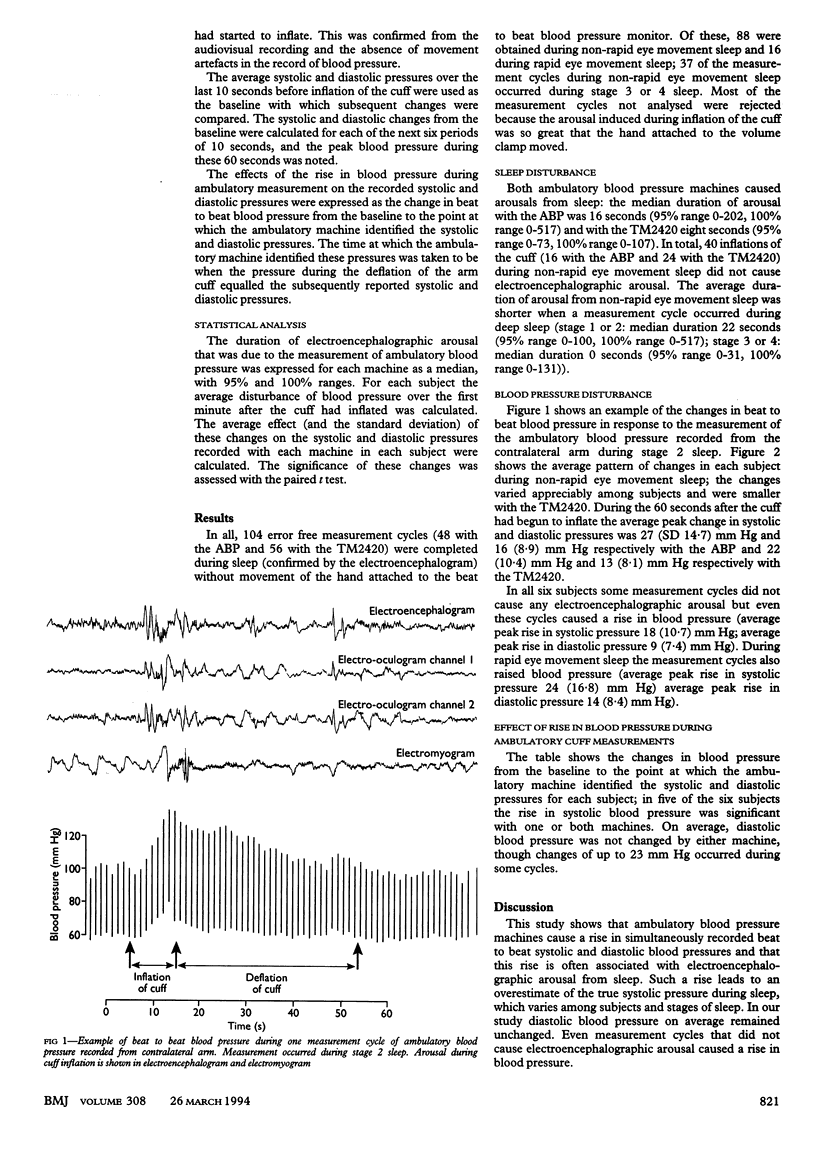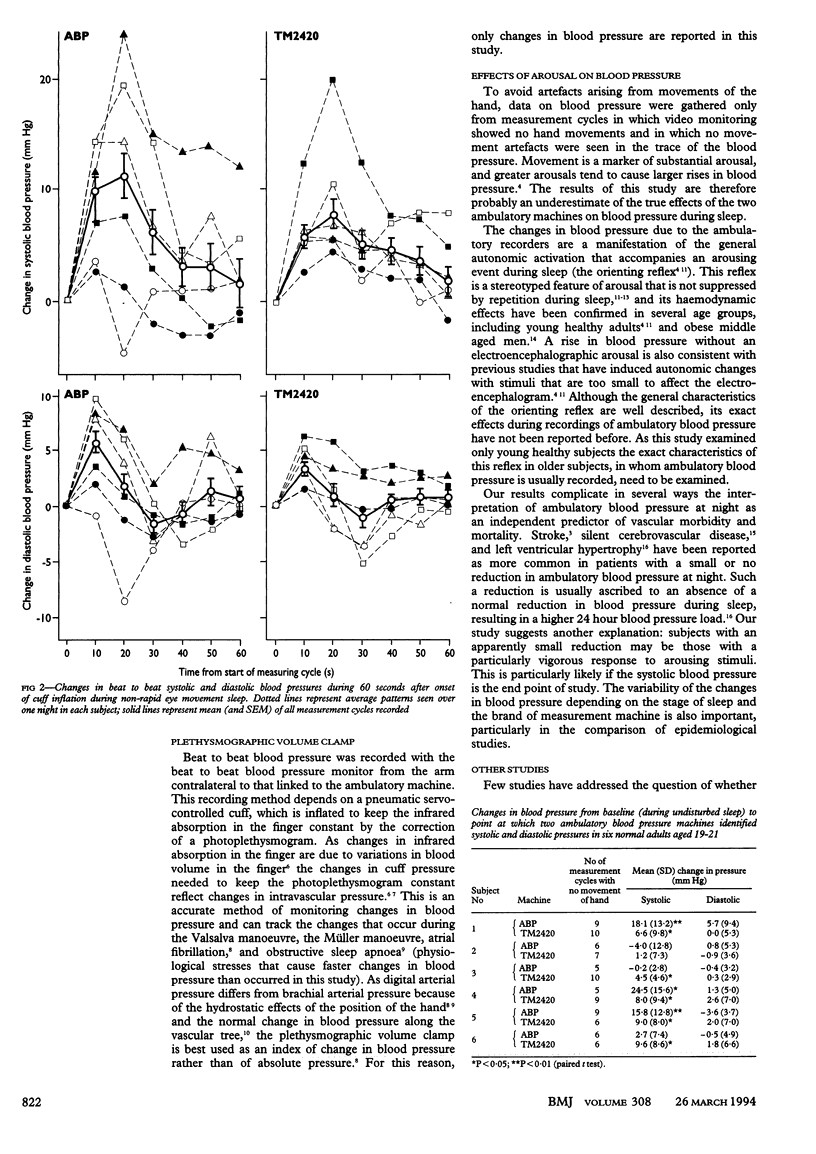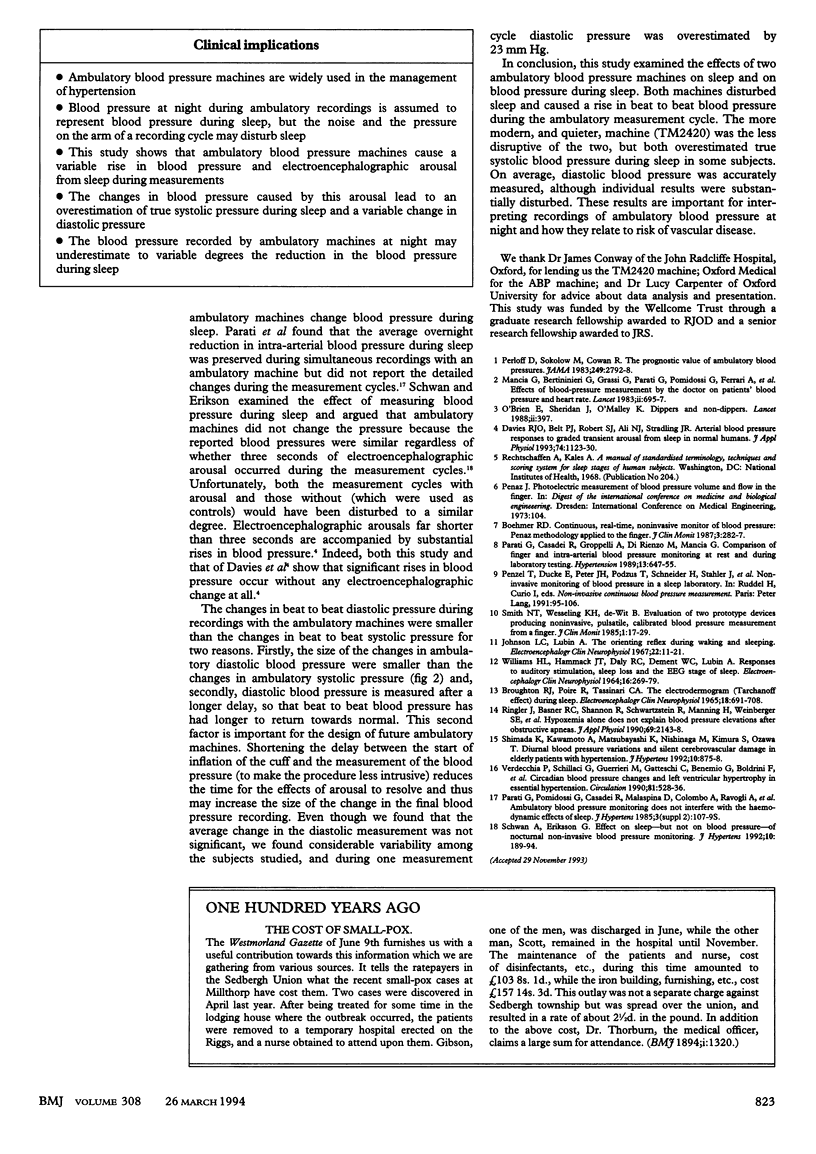Abstract
OBJECTIVE--To assess whether recording of ambulatory blood pressure at night causes arousal from sleep and a change in the continuous blood pressure recorded simultaneously. DESIGN--Repeated measurement of blood pressure with two ambulatory blood pressure machines (Oxford Medical ABP and A&D TM2420) during continuous measurement of beat to beat blood pressure and continuous electroencephalography. SETTING--Sleep research laboratory. SUBJECTS--Six normal subjects. MAIN OUTCOME MEASURES--The duration of electroencephalographic arousal and the beat to beat changes in blood pressure produced by the measurement of ambulatory blood pressure; the size of any changes that this arousal and change in blood pressure produced in the blood pressure recorded by the ambulatory machine. RESULTS--Both ambulatory blood pressure machines caused arousal from sleep: the mean duration of arousal was 16 seconds (95% range 0-202) with the ABP and 8 seconds (0-73) with the TM2420. Both also caused a rise in beat to beat blood pressure. During non-rapid eye movement sleep, this rise led to the ABP machine overestimating the true systolic blood pressure during sleep by a mean of 10 (SD 14.8) mm Hg and the TM2420 by a mean of 6.3 (8.2) mm Hg. On average, diastolic pressure was not changed, but measurements in individual subjects changed by up to 23 mm Hg. These changes varied in size among subjects and stages of sleep and were seen after measurements that did not cause any electroencephalographic arousal. CONCLUSIONS--Ambulatory blood pressure machines cause appreciable arousal from sleep and therefore alter the blood pressure that they are trying to record. This effect should be taken into account when recordings of blood pressure at night are interpreted in clinical work and epidemiological research.
Full text
PDF



Selected References
These references are in PubMed. This may not be the complete list of references from this article.
- BROUGHTON R. J., POIRE R., TASSINARI C. A. THE ELECTRODERMOGRAM (TARCHANOFF EFFECT) DURING SLEEP. Electroencephalogr Clin Neurophysiol. 1965 Jun;18:691–708. doi: 10.1016/0013-4694(65)90113-6. [DOI] [PubMed] [Google Scholar]
- Boehmer R. D. Continuous, real-time, noninvasive monitor of blood pressure: Penaz methodology applied to the finger. J Clin Monit. 1987 Oct;3(4):282–287. doi: 10.1007/BF03337384. [DOI] [PubMed] [Google Scholar]
- Johnson L. C., Lubin A. The orienting reflex during waking and sleeping. Electroencephalogr Clin Neurophysiol. 1967 Jan;22(1):11–21. doi: 10.1016/0013-4694(67)90004-1. [DOI] [PubMed] [Google Scholar]
- Mancia G., Bertinieri G., Grassi G., Parati G., Pomidossi G., Ferrari A., Gregorini L., Zanchetti A. Effects of blood-pressure measurement by the doctor on patient's blood pressure and heart rate. Lancet. 1983 Sep 24;2(8352):695–698. doi: 10.1016/s0140-6736(83)92244-4. [DOI] [PubMed] [Google Scholar]
- O'Brien E., Sheridan J., O'Malley K. Dippers and non-dippers. Lancet. 1988 Aug 13;2(8607):397–397. doi: 10.1016/s0140-6736(88)92867-x. [DOI] [PubMed] [Google Scholar]
- Parati G., Casadei R., Groppelli A., Di Rienzo M., Mancia G. Comparison of finger and intra-arterial blood pressure monitoring at rest and during laboratory testing. Hypertension. 1989 Jun;13(6 Pt 1):647–655. doi: 10.1161/01.hyp.13.6.647. [DOI] [PubMed] [Google Scholar]
- Perloff D., Sokolow M., Cowan R. The prognostic value of ambulatory blood pressures. JAMA. 1983 May 27;249(20):2792–2798. [PubMed] [Google Scholar]
- Ringler J., Basner R. C., Shannon R., Schwartzstein R., Manning H., Weinberger S. E., Weiss J. W. Hypoxemia alone does not explain blood pressure elevations after obstructive apneas. J Appl Physiol (1985) 1990 Dec;69(6):2143–2148. doi: 10.1152/jappl.1990.69.6.2143. [DOI] [PubMed] [Google Scholar]
- Schwan A., Eriksson G. Effect on sleep--but not on blood pressure--of nocturnal non-invasive blood pressure monitoring. J Hypertens. 1992 Feb;10(2):189–194. doi: 10.1097/00004872-199202000-00013. [DOI] [PubMed] [Google Scholar]
- Shimada K., Kawamoto A., Matsubayashi K., Nishinaga M., Kimura S., Ozawa T. Diurnal blood pressure variations and silent cerebrovascular damage in elderly patients with hypertension. J Hypertens. 1992 Aug;10(8):875–878. [PubMed] [Google Scholar]
- Smith N. T., Wesseling K. H., de Wit B. Evaluation of two prototype devices producing noninvasive, pulsatile, calibrated blood pressure measurement from a finger. J Clin Monit. 1985 Jan;1(1):17–29. doi: 10.1007/BF02832685. [DOI] [PubMed] [Google Scholar]
- Verdecchia P., Schillaci G., Guerrieri M., Gatteschi C., Benemio G., Boldrini F., Porcellati C. Circadian blood pressure changes and left ventricular hypertrophy in essential hypertension. Circulation. 1990 Feb;81(2):528–536. doi: 10.1161/01.cir.81.2.528. [DOI] [PubMed] [Google Scholar]
- WILLIAMS H. L., HAMMACK J. T., DALY R. L., DEMENT W. C., LUBIN A. RESPONSES TO AUDITORY STIMULATION, SLEEP LOSS AND THE EEG STAGES OF SLEEP. Electroencephalogr Clin Neurophysiol. 1964 Mar;16:269–279. doi: 10.1016/0013-4694(64)90109-9. [DOI] [PubMed] [Google Scholar]


